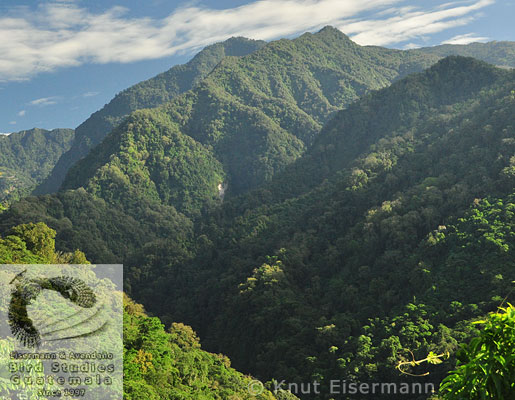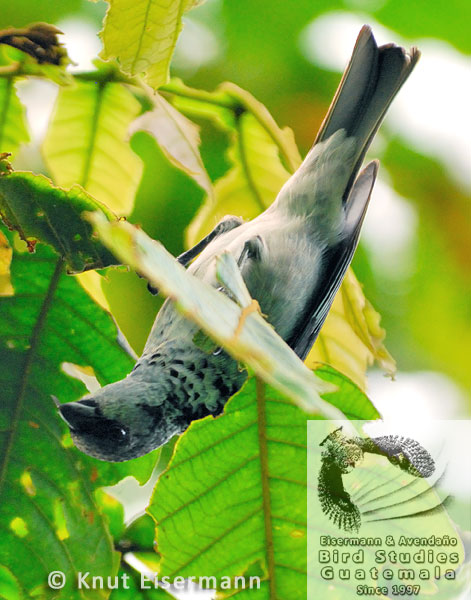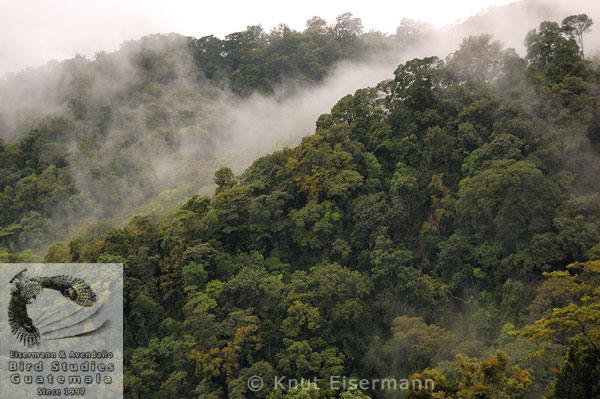Azure-rumped Tanager (Poecilostreptus cabanisi) in Guatemala
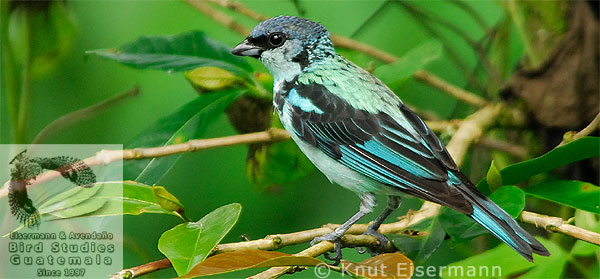
Knut Eisermann and Claudia Avendaño have been studying the ecology of Azure-rumped Tanager (Poecilostreptus cabanisi, formerly Tangara cabanisi) since 2007, including distribution, habitat use, nesting ecology, and vocalizations. Results were published in the following papers:
Eisermann, K. & C. Avendaño (2018) An update on the inventory, distribution and residency status of bird species in Guatemala. Bulletin British Ornithologists' Club 138: 148-229. PDF
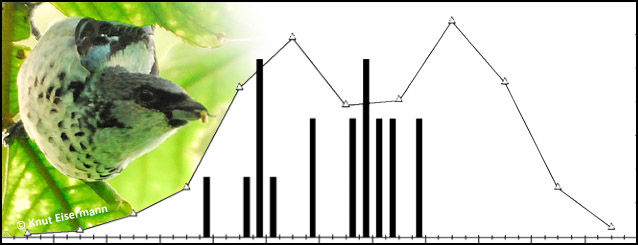
Eisermann, K., S. Arbeiter, G. López, C. Avendaño & J. d. León Lux (2011) Distribution, habitat use, and implications for the conservation of the globally threatened Azure-rumped Tanager Tangara cabanisi in Guatemala. Bird Conservation International 21: 423-437.
Abstract: The Azure-rumped Tanager Tangara cabanisi is a globally threatened species restricted to the
Pacific slope mountains of western Guatemala and Chiapas, Mexico. We studied the habitat use of
this tanager on the southern slope of Atitlán volcano, department Suchitepéquez, Guatemala,
applying distance sampling along transects in humid broadleaf forest and coffee plantations. The
tanager was recorded in both habitat types, but encounter rates were significantly greater in
broadleaf forest. The estimated density of tanagers in forest at 1,400-1,900 m was 33-93 birds /
km2. Tanagers were recorded mainly in the upper vegetation strata of forest and shade coffee
plantations. In coffee plantations tanagers used mainly tall solitary trees or the canopy of shade
trees, which were dominated by Inga spp. The number of observations of feeding tanagers in
Ficus aurea (Moraceae) indicated a high importance of this food source. The density of F. aurea
trees and the encounter rate of tanagers were positively correlated. From 1987 to 2009 tanagers
have been recorded at nine topographic units and a total of 16 sites in Guatemala, in the
departments of San Marcos, Quetzaltenango, Sololá, Suchitepéquez, and Chimaltenango. We
analysed the available habitat for tanagers in the potential area of distribution (1,170 km2),
ranging from 900 to 1,900 m altitude and from the Mexican border in the West to the
municipality of Pochuta in the East. Broadleaf forest covers 250 km2 or 21% of the potential area
of distribution, and coffee plantations cover 800 km2 or 68%. Assuming that population density
in prime habitat throughout the potential distribution range is similar to our study area at Atitlán
volcano, total tanager population in Guatemala is estimated to be 8,250-23,250 birds. Our
findings support the maintenance of the IUCN Red List status of Endangered EN B1a+b(ii,iii,v).
To enhance the available habitat for Azure-rumped Tanager, we propose alterations in the shade
management of coffee plantations, supported by incentives and certification programmes. PDF
Eisermann, K., S. Arbeiter, G. López, C. Avendaño, J. de León Lux, A. Burge, A. de León Lux & E. Buchán (2011). Nesting ecology of the Endangered Azure-rumped Tanager (Tangara cabanisi) in Guatemala. Ornitología Neotropical 22: 39-57.
Abstract: The Azure-rumped Tanager (Tangara cabanisi) is a little studied and endangered species
restricted to the Pacific slope mountains of Guatemala and Chiapas, Mexico. We studied the nesting
ecology of this species on the south-eastern slope of Atitlán volcano, dpto. Suchitepéquez, Guatemala,
and compiled information of other nesting sites. Thirty-two nests were recorded in Guatemala from
2001-2009, of which 30 were observed at Atitlán volcano. The altitude of nesting sites ranged from 860
to 1850 m. Fifteen nests were located in broadleaf forest with a distance to the nearest forest edge ranging
from 0-700 m. Another 17 nests were in coffee plantations and orchard-like habitat with a distance
from the nearest forest ranging from 5-130 m. We recorded tanagers nesting successfully in primary
broadleaf forest, but also in plantations with a greatly reduced or absent upper canopy of native broadleaf
trees. The 32 nests were placed in 20 different tree species. Nesting was observed in all months
from April through September and was synchronized with the wet season. One nest provided data from the first day of nest-building to the fledging of juveniles. Nest-building took six days, incubation 14 days,
and brooding 17 days, which is longer than the nestling period observed previously for the Azure-rumped
Tanager in Chiapas and for congeners throughout the Neotropics. Using the Mayfield method for calculating
nest survival from onset of incubation to the fledging of the first young, nest success was 16%
(95% confidence interval: 5-45%). Our findings provide a base for practical conservation measures in
the coffee-dominated landscape of the Guatemalan and Chiapan Pacific slope highlands. PDF
Eisermann, K., G. López, J. Berry, J. de León Lux & A. Burge (2011) Vocalisations and juvenile plumage of the Azure-rumped Tanager. Cotinga 33: 23-26. PDF
Eisermann, K. (2011) Azure-rumped Tanager Tangara cabanisi: from ornithological enigma to conservation flagship. Neotropical Birding 9: 44-50. PDF
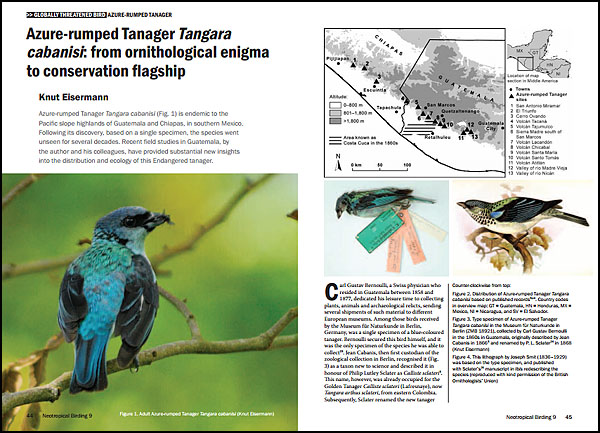
Eisermann, K. (2011) Azure-rumped Tanager (Tangara cabanisi), Neotropical Birds Online (T. S. Schulenberg, Editor). Cornell Lab of Ornithology, Ithaca; NY.
Eisermann, K. (2020). Azure-rumped Tanager (Poecilostreptus cabanisi), version 1.0. In Birds of the World (T. S. Schulenberg, Editor). Cornell Lab of Ornithology, Ithaca, NY, USA. https://doi.org/10.2173/bow.azrtan1.01
